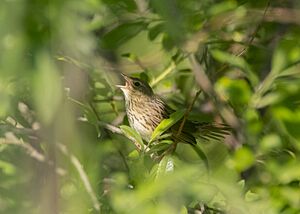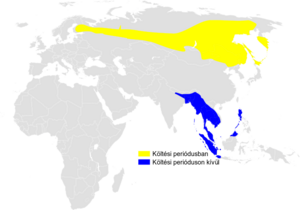Lanceolated warbler facts for kids
Quick facts for kids Lanceolated warbler |
|
|---|---|
 |
|
| near Novosibirsk, Russia | |
| Conservation status | |
| Scientific classification | |
| Genus: |
Locustella
|
| Species: |
lanceolata
|
 |
|
| Distribution of Lanceolated Warbler Breeding Non-breeding | |
The lanceolated warbler is a small, brown bird known for its shy nature. Its scientific name is Locustella lanceolata. This bird lives in many parts of Asia and Europe. It is a type of Old World warbler, which means it belongs to a group of small songbirds found mostly in Europe, Asia, and Africa.
The name Locustella comes from a Latin word meaning "little grasshopper." This is because some birds in this group make sounds that are similar to grasshoppers. The word lanceolata is also Latin and means "spear-shaped." This refers to the cool, spear-like streaks you can see on the bird's chest.
Contents
What Does the Lanceolated Warbler Look Like?
This warbler is a small passerine bird, which means it's a type of perching bird. Adult lanceolated warblers have brown backs with streaks. Their undersides are whitish-grey. You can also see small, spear-shaped streaks on their chest and under their tail.
Both male and female warblers look very similar. Young birds, however, might look a bit more yellow on their undersides. Like most warblers, they are insectivorous, meaning they mostly eat insects.
Where Do Lanceolated Warblers Live?
Lanceolated warblers breed, or have their babies, in a wide area. This includes northeast European Russia and across the Palearctic region. This region covers much of Europe and Asia. They also breed as far east as northern Hokkaidō, Japan.
Their Habitat
These birds like to live in grasslands. They prefer areas with some thicker bushes or small trees. You often find them near water, like in bogs or wet clearings. They build their nests in clumps of grass and usually lay about five eggs.
Migration
The lanceolated warbler is a migratory bird. This means it travels long distances between its breeding grounds and its winter homes. They spend their winters in warmer places, mainly in Southeast Asia.
Sometimes, these birds can travel far off their usual path. They are considered a rare vagrant in western Europe. This means they sometimes show up in places where they don't normally live. One of the best places to spot them as a vagrant is Fair Isle in the Shetland Islands.
How Do They Behave and Sing?
The lanceolated warbler is a very shy bird. It is known as a "skulking" species. This means it likes to hide and move secretly through tall grass and low plants. Because of this, it can be very hard to spot! You might only see it when it is singing.
Their Song
The song of the lanceolated warbler is quite unique. It sounds like a steady, mechanical reeling noise. Many other birds in the Locustella group have similar songs. It often sounds like an insect and is usually heard around dusk, which is early evening.
Types of Lanceolated Warblers
Scientists have identified two main types, or subspecies, of the lanceolated warbler:
- L. l. lanceolata
- L. l. hendersonii



